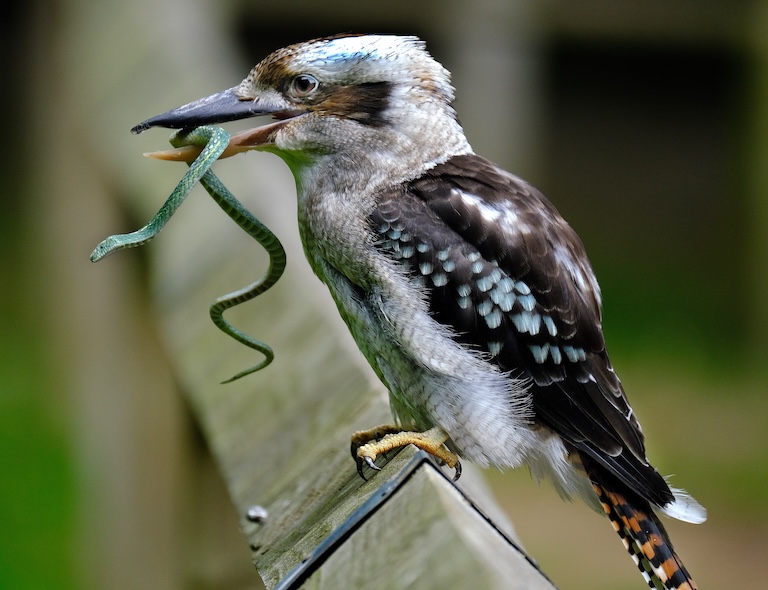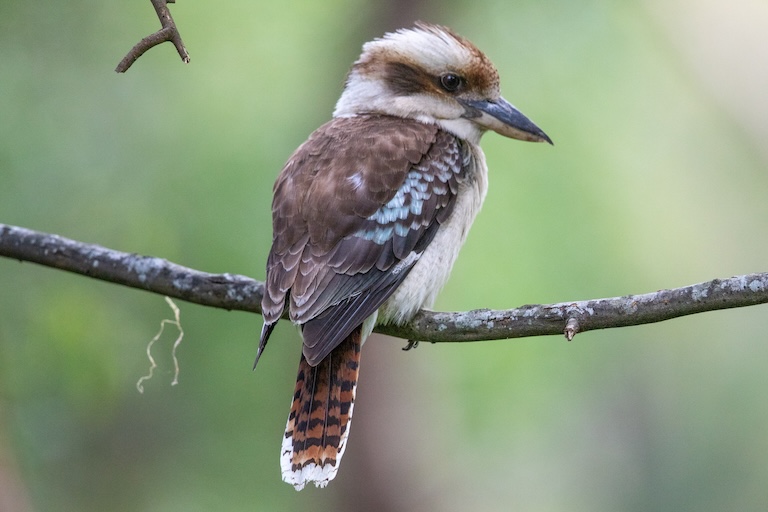Laughing Kookaburra Profile
If you hear Australians complaining about the laughing jackass that woke them up at dawn, the culprit may not be the bogan you were expecting.
Another name for this laughing jackass stems from the Wiradjuri people’s word gugabarra, which, if you miraculously missed the title above this intro, should more or less ruin the suspense.
Other nicknames of the Kookaburra include Great Brown Kingfisher, which, as it turns out, is taxonomically and aesthetically accurate, and this particular kingfisher is one of the most iconic birds of the Australian woodlands; one whose characteristic call and dashing good looks have made it popular with the human residents since long before the Europeans arrives.

Laughing Kookaburra Facts Overview
| Habitat: | Tree canopy, commonly inside the Mountain Gum tree |
| Location: | Eastern and Southern Australia |
| Lifespan: | Over 20 years |
| Size: | 41–47 cm (16–19 in) long |
| Weight: | 190–465 g (6.7–16.4 oz) |
| Colour: | Mostly mottled grey with dark brown, flecked wings and a dark eye stripe; reddish tail. |
| Diet: | Primarily snakes, large lizards, worms, snails, insects, freshwater crayfish, frogs, small birds and rodents |
| Predators: | Wedge-tailed eagles, cats, brown goshawks, large owls, foxes and grey butcher birds |
| Top Speed: | Unknown |
| No. of Species: | 1 |
| Conservation Status: | Least Concern |
The laughing kookaburra is a very large kingfisher, able to take on prey far bigger than most in its family.
These arboreal predators are best known for their distinctive calls, which are unusual in their ability to produce overtones, but they’re also respected as handy pest control and as cooperative breeders with unusual habits.
The call isn’t just distinctive, it’s also complex, with multiple frequencies expressed in harmony. These are birds with a hard start in life, who often grow up to work together.
Interesting Laughing Kookaburra Facts
1. They’re kingfishers
Kingfishers are in the Coraciiformes order, a word that essentially means raven-shaped, and an order that contains lots of very pretty animals like the bee-eaters and rollers.
These are typically predatory birds and are known to persuasively smash their victims against rocks to get them to agree to being eaten.
The kingfishers are a whole family in the order, and these, too are often brightly coloured and very pretty predators, with quite a range of behaviours.
While mostly tropical, there are species of kingfisher found almost everywhere there’s something small and animal-like to eat.
Within this family, the tree kingfishers are the majority of species, and make up a large subfamily. There are around 12 genera of these, the kookaburras being one, and of the 12 species, our friend here is the largest.
You’d think the giant kingfisher would hold this title, and if you go by length measurements, it inches ahead, but in terms of mass, the laughing kookaburra is the boss.

2. They’re predators
Birds, like house cats, have the paradoxical ability to be adorable and brutal at the same time. The handsome kingfishers often feed on animals that don’t scream or cry, so we sort of overlook it, but one this large ventures into a more recognisable brutality to our eyes.
The giant kingfisher is a muscular bird with a powerful beak and it uses this to attack large lizards, frogs, other birds and even rodents.
There’s something about birds eating mammals that can give you flashbacks in your DNA and make you distinctly uncomfortable, but as soon as this bird opens its mouth, you forget about it.
3. They’re polyphonic
If you’ve ever done that thing where you hum and whistle at the same time, you’ve been polyphonic too. Well done! Mongolians figured this out with their throat signing, but it predates our species, likely by millions or years.
The laugh of the kookaburra is an example of overtone, or polyphonic calling, making use of two separate sound-producing mechanisms at the same time. This means it can produce harmonic frequencies, essentially duetting with itself.
But it doesn’t do this out of necessity – there are plenty of opportunities to sing with a partner.
4. They duet
When you have two kookaburras communicating, the first may start with a hiccup-like chuckle, and much like the bubbling cacophony of chimps greeting one another, the bird gradually ramps up its excitement until it’s roaring with laughter.
Before the first has finished, others join the fun, and when rivals are in earshot, it’s a riot.
Calls are used for various purposes: some are to gather mates, others to establish and protect territories, and duets in particular are a great way for friendly groups to show to rivals that they’re tight and not to be messed with.
Due to the complexity of the calls, juveniles need to be taught to sing like their parents, usually by the male, who will break down the call into digestible practice packets for the infant. It’ll be at least a fortnight before the baby learns the song and joins in with the evening scream fest.
Duetting requires cooperation, and this is thought to not only form stronger bonds within the group but also force a certain level of cognitive skill in the species.
In-group cooperation is well documented, but there’s also evidence that neighbouring groups work together with one another, too. 1
5. They’re cooperative
Lots of bird species are cooperative breeders and researchers are still figuring out whether this correlates with the complexity of their vocalisations.
If it does, it’s no wonder the laughing kookaburra teams up to take care of young, and groups often consist of a mating pair and a handful of helpers who may or may not be their offspring from previous years.
Helpers are mostly male and help to build the nest and bring the female towels and a glass of water when it’s time for her to lay eggs, but they can be of either sex, and there may be up to six of them to a pair.
Mating is monogamous, but the helpers themselves work their way up the chain of command and may bud off to form their own little clans. 2 3
6. After a while
All of this comradery is a lovely image of the kookaburra but it comes with a lot of skeletons in the closet.
Each of these helpful birds is likely to have murdered its sibling in the nest to get to where it is now in the kind of ruthless battle royale you’d expect from Silicon Valley types. Three eggs are usually hatched, with up to three days between them, giving the first bird a significant advantage over its siblings.
In a third of cases, the youngest will be pecked to death by its elders, using a hook in the beak specifically evolved for killing siblings with.
This so-called “kookaburra siblicide syndrome” is triggered by a number of variables including a particularly weedy third kid; a lack of male helpers around the home; a male and female preceding pair; and/or in cases where the first two siblings hatch simultaneously.
7. They’re popular
Despite their murderous beginnings, the surviving birds grow up to be very popular animals, not only for their pretty sounds and buckets of character but also because they help keep pests off farms.
They were popular among the colonisers because they kept snake populations down, and are still considered useful in the prevention of insect outbreaks. 4

Laughing Kookaburra Fact-File Summary
Scientific Classification
| Kingdom: | Animalia |
| Phylum: | Chordata |
| Class: | Aves |
| Order: | Coraciiformes |
| Family: | Alcedinidae |
| Genus: | Dacelo |
| Species: | novaeguineae |
Fact Sources & References
- “Laughing Kookaburra”, Cornell Lab.
- Myron C. Baker (2004), “The Chorus Song of Cooperatively Breeding Laughing Kookaburras”, Wiley Online Library.
- S. Legge & A. Cockburn (2000), “Social and mating system of cooperatively breeding laughing kookaburras (Dacelo novaeguineae)”, Springer Nature Link.
- Laura Sholtis “Dacelo novaeguineae laughing kookaburra”, Animal Diversity Web.
